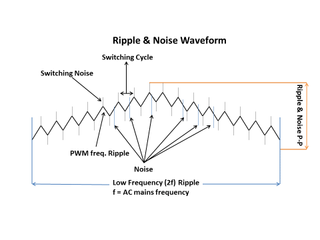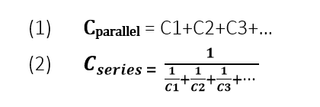PSUs 101: A Detailed Look Into Power Supplies
The objective of this article is to provide detailed information about the most crucial part of a personal computer (PC) system, its power supply unit. Follow us on this journey into PSU territory and we promise that you will gain valuable knowledge.
Capacitors
Capacitors can be used to smooth out voltage, a process also known as filter ripple. They can also be used as reservoirs for electrical energy storage and to block DC current. A capacitor consists of two metal plates that are separated by an insulator, the dielectric. One of the most notable features of capacitors is that they resist voltage changes, meaning that if suddenly the voltage applied to a capacitor is changed the capacitor cannot react immediately and the voltage across the capacitor changes more slowly compared to the applied voltage.

What is the "Primary" Side and "Secondary" Side?
In a PSU, capacitors are used in both the "primary" side and the "secondary" side. The primary side is the part of a PSU before the power transformer, where the AC comes in. The secondary side is after the power transformer and this is the part that actually generates the DC outputs. More on this in the SMPS section.
Capacitors allow DC to pass for a very short period of time before they block it. On the contrary, AC passes freely through them, but with a changed, rectified, shape. We calculate the charge a capacitor can store, called capacitance, in farads. However, a farad (F) is a very large unit so you will usually see micro-farad (µF or uF) or pico-farad (pF) units used instead. Besides their capacity, the two most significant features of a capacitor are its working voltage and the temperature rating (and for those that have polarity, the negative lead marking).
In PSUs, the best electrolytic capacitors are considered those rated at 105 degrees Celsius, since they have increased life span compared with ones rated at 85 °C. Of course, the capacitor manufacturer plays a key role, with Japanese-made capacitors always being the preferred choice.

There are various types of capacitors depending on their construction and the materials used. Some of the most common types are dielectric, film, ceramic, electrolytic, glass, tantalum and polymer. In PSUs, we mostly see electrolytic and polymer capacitors and, in the transient filtering/APFC (active power correction factor) stage, Y (ceramic) and X (metalized polyester) capacitors. In all cases, Y capacitors are placed between line and earth (or chassis) and always come in pairs, while X capacitors are placed across the line (connected between line and neutral). And since X capacitors tend to keep their charge for quite a long time, a bleeding resistor is often used to quickly de-charge them once the AC voltage is removed. If there is a short circuit in Y caps, there is a high risk of an electric shock to the user, and if an X cap shorts out, there is a fire risk.




If we place two or more capacitors in parallel, then their capacitances are added (equation 1 below). On the contrary, if we connect them in a series, then their total capacitance is reduced (equation 2).

The perfect capacitor should have zero resistance, which is defined as an object's opposition to electron flow. However, as this isn't a perfect world, all capacitors have some resistance, and the lower it is, the higher the quality of the capacitor. A cap's resistance is called equivalent series resistance (ESR), and it can hugely affect performance.
When we are trying to figure out the cause of a malfunction in a PSU, we shouldn't only measure the capacitance of its caps; we should also check ESR readings using the proper instrument. In many cases, capacitance might be within specifications but the ESR is way off, resulting in poor performance. Also, increased ESR greatly affects the operational temperature of a cap leading to its fast degradation and a much shorter life span. Even a 10 °C increase in the operating temperature of an electrolytic cap cuts its estimated lifetime, which shows the importance of keeping an electrolytic cap's temperature at the lowest possible levels.




In short, the most crucial specifications of a capacitor are the following:
- Working voltage (if exceeded for prolonged periods, the cap will most likely fail, making a loud bang).
- Working temperature.
- Capacitance.
- Tolerance (expressed in percentages, it shows how close a cap's capacitance is to its nominal level).
- Polarity (for electrolytic caps).
- ESR (equivalent series resistance).
- Ripple current.
- Leakage current (current "leaking" through the dielectric due to its poor isolation resistance).
- Size (since larger caps can dissipate heat easier and on top of that have more dielectric quantity).
Current page: Capacitors
Prev Page Inductors And Transformers Next Page Current Ripple And Cap Life CalculationStay On the Cutting Edge: Get the Tom's Hardware Newsletter
Join the experts who read Tom's Hardware for the inside track on enthusiast PC tech news — and have for over 25 years. We'll send breaking news and in-depth reviews of CPUs, GPUs, AI, maker hardware and more straight to your inbox.
Aris Mpitziopoulos is a Contributing Editor at Tom's Hardware US, covering PSUs.
-
Alexis Shaw In your list of top-tier capacitor manufacturers you missed out on some of the better american and european manufacturers, while these may not be used on many consumer-grade power supplies they are definitely top-tier and if you were to find them you would be happy. I suggest the addition of at least:Reply
Cornell Dubilier (USA)
Illinois Capacitor (Now owned my Cornell Dubilier)
Kemet Corporation (USA)
ELNA (Japan)
EPCOS (TDK company) (Germany)
Vishay (USA)
Würth Elektronik (Germany)
-
Aris_Mp Thank you very much for the list you provided. I am aware of almost all cap brands that you mentioned but unfortunately so far I found none of them inside a desktop/consumer grade PSU. I will think about it however (and also make a research on these cap brands), if I should include them as well inside my list.Reply
-
InvalidError Reply
There is a very high probability you have seen PSUs with several Kemet capacitors in them. You never noticed them simply because SMD capacitors are too small to carry logos, brand name or even value designations.16585466 said:Thank you very much for the list you provided. I am aware of almost all cap brands that you mentioned but unfortunately so far I found none of them inside a desktop/consumer grade PSU.
The other brands are mostly found in specialty applications such as lab instruments, industrial machines and high-end audio. -
Math Geek very interesting read. more in depth than i need to know yet for the most part understandable and with careful reading it did not leave me confused.Reply
nice article. -
TallestJon96 I only read 2/3 of it, but it's a good article.Reply
I basically have committed PC heresy with my cx600m. However I think that I'm in the clear with my 65w CPU and 145w CPU. I'd bet my total power draw is actually below 300w, the supposed highest efficiency point of a PSU.
As a gamer, not a professional, I think it is better to get low power parts, and get a higher rating than you need, rather than get high power parts and high quality PSUs.
Additionally, if you compare power consumption of a typical system from today to one from 5 years ago, power draw is considerably lower, with the exception of certain graphics cards. *cough* 390x *cough* -
powernod I decided to sign up at Tom's forum, and the only reason was to state how excellent is Aris's article!!!Reply
Thanks Aris for this very useful article on behalf of us all who want to learn the basic knowledge for PSUs.
Haven't finished it yet, but i'm very anxious for it !!! -
traumadisaster I'm glad there are people dedicated to this but I'm not. I can't even read all of the chapter titles in this article. I disagree with the importance you place on this and all of the references you made to this being crucial knowledge.Reply
PSU and MB are insignificant to me and I can blindly pick one by reviewing user comments from newegg in about 5 min, and it will last for years. For less than $100 each I'm set for nearly a decade.
CPU and gfx card now that affects fps and is over $1000, actually the most important part to me. -
Alexis Shaw Reply16589602 said:I'm glad there are people dedicated to this but I'm not. I can't even read all of the chapter titles in this article. I disagree with the importance you place on this and all of the references you made to this being crucial knowledge.
PSU and MB are insignificant to me and I can blindly pick one by reviewing user comments from newegg in about 5 min, and it will last for years. For less than $100 each I'm set for nearly a decade.
CPU and gfx card now that affects fps and is over $1000, actually the most important part to me.
I heartily dissagree, user are not the best way to judge reliability, and a bad powersupply is at fult most of the time there is a hardware issue. Further a power supply should last more than one system build, and in general I keep mine for a decade at a time at least. So an investment in a good power supply is not a waste, and a bad one will kill that precious $1000 GPU or CPU. The demo dart power supply on the motherboard is a similar story, however in general they are of higher quality than a cheap mains supply.
-
Alexis Shaw Reply16585679 said:
There is a very high probability you have seen PSUs with several Kemet capacitors in them. You never noticed them simply because SMD capacitors are too small to carry logos, brand name or even value designations.16585466 said:Thank you very much for the list you provided. I am aware of almost all cap brands that you mentioned but unfortunately so far I found none of them inside a desktop/consumer grade PSU.
The other brands are mostly found in specialty applications such as lab instruments, industrial machines and high-end audio.
As well as SMT ceramic capacitors, Kemet makes through hole aluminium electrolytic capacitors. These are of high quality, though not as well known as their SMT capacitors. They also make high quality polymer SMT capacitors that are used as bulk capacitors on the power distribution circuitry on laptops and other devices.